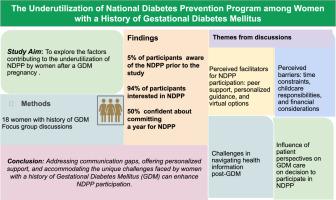The Underutilization of National Diabetes Prevention Program Among Women With a History of Gestational Diabetes Mellitus: An In-Depth Focus Group Analysis
引用次数: 0
Abstract
Introduction
Gestational diabetes mellitus significantly increases the risk of developing Type 2 diabetes mellitus in women. However, the National Diabetes Prevention Program, effective in reducing Type 2 diabetes mellitus incidence, is underutilized among women with a history of gestational diabetes mellitus. This study aims to explore the factors contributing to this underutilization and propose strategies to increase National Diabetes Prevention Program's usage.
Methods
A qualitative study with narrative methodology was employed, involving focus group discussions with 18 women aged between 29 and 43 years, who had a history of gestational diabetes mellitus. Participants were recruited from a gestational diabetes mellitus registry through University of California, San Diego's online platform. The discussions were aimed at understanding their awareness of Type 2 diabetes mellitus risk after gestational diabetes mellitus and their knowledge about the National Diabetes Prevention Program.
Results
Thematic analysis of the discussions revealed 4 key themes: (1) challenges in navigating health information after gestational diabetes mellitus; (2) perceived facilitators for National Diabetes Prevention Program participation, including peer support, personalized guidance, and virtual options; (3) perceived barriers, such as time constraints, childcare responsibilities, and financial considerations; and (4) insights into patient perspectives on gestational diabetes mellitus care. Despite awareness of their increased Type 2 diabetes mellitus risk, there was a notable gap in knowledge about the National Diabetes Prevention Program among participants.
Conclusions
The study highlights the critical need for improved communication regarding postgestational diabetes mellitus risk of type 2 diabetes and the National Diabetes Prevention Program. Addressing communication gaps, offering personalized support, and accommodating the unique challenges faced by women with a history of gestational diabetes mellitus can enhance National Diabetes Prevention Program participation. The significance of a patient-centric approach in diabetes prevention is underscored, emphasizing that such an approach could significantly impact Type 2 diabetes mellitus prevention in this high-risk population.

有妊娠糖尿病史的妇女对国家糖尿病预防计划的利用不足:焦点小组深入分析
导言妊娠糖尿病会大大增加女性罹患 2 型糖尿病的风险。然而,能有效降低2型糖尿病发病率的 "国家糖尿病预防计划 "在有妊娠糖尿病史的妇女中却未得到充分利用。本研究旨在探讨导致利用率不足的因素,并提出提高国家糖尿病预防计划利用率的策略。研究方法采用叙事方法进行定性研究,与 18 名年龄在 29 岁至 43 岁之间、有妊娠糖尿病史的女性进行焦点小组讨论。参与者是通过加州大学圣地亚哥分校的在线平台从妊娠糖尿病登记处招募的。讨论旨在了解他们对妊娠糖尿病后 2 型糖尿病风险的认识以及他们对国家糖尿病预防计划的了解。结果对讨论的专题分析揭示了 4 个关键主题:(1)妊娠糖尿病后浏览健康信息的挑战;(2)参与国家糖尿病预防计划的促进因素,包括同伴支持、个性化指导和虚拟选项;(3)感知到的障碍,如时间限制、育儿责任和经济考虑;以及(4)患者对妊娠糖尿病护理的见解。尽管参与者意识到自己患 2 型糖尿病的风险在增加,但他们对国家糖尿病预防计划的了解还存在明显差距。弥补沟通方面的不足、提供个性化支持以及应对有妊娠糖尿病史的妇女所面临的独特挑战,可以提高全国糖尿病预防计划的参与度。以患者为中心的方法在糖尿病预防中的重要性得到了强调,并强调这种方法可对这一高风险人群的2型糖尿病预防产生重大影响。
本文章由计算机程序翻译,如有差异,请以英文原文为准。
求助全文
约1分钟内获得全文
求助全文

 求助内容:
求助内容: 应助结果提醒方式:
应助结果提醒方式:


